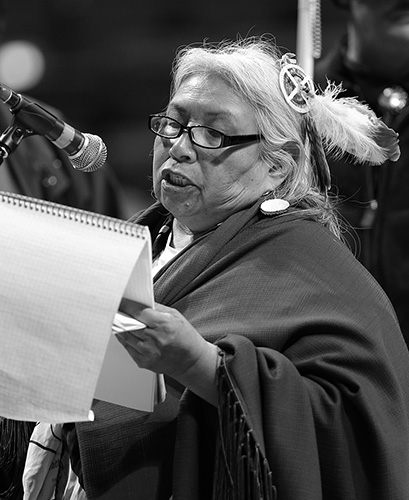54: “We Will Be There to Meet You” (2013)34
Armando Iron Elk and Faith Spotted Eagle
The Keystone Pipeline, a vast system that carries oil from Alberta, Canada, through the Dakotas and Nebraska and then branches into Illinois and Texas, traverses nearly 3,000 miles. Keystone XL, a proposed fourth phase, would add another 2,100 miles to the system and cut diagonally from Alberta, through the Bakken region in Montana, and end in Steele City, Nebraska. In getting there, the pipeline would cut through environmentally sensitive areas, including the vital Ogallala Aquifer. First Nations and American Indian activists allied to protest Keystone XL on a number of grounds including carbon dioxide emissions, the disruption of sacred and ancestral sites, and the potential for water contamination. In March 2012, the Black Hills Sioux Nation Treaty Council took direct action by establishing a blockade to prevent trucks carrying equipment for the pipeline from crossing through the Pine Ridge Reservation. Consider how, in this hearing before officials from the State Department in 2013, Lakota activists Armando Iron Elk Sr. and Faith Spotted Eagle called upon the sacredness of creation and treaties as living documents to condemn Keystone XL.35
Armando Iron Elk Sr. I am an elected Treaty Council official of the Ihanktonwan [Iháŋktȟuŋwaŋ—Yankton, “(those) dwelling at the end”]. I present the Department of State with a copy of our new 2013 international treaty to protect the sacred against the tar sands and our resolve to stop this destruction of our land. I leave this message for you. We affirm that our laws define our solemn duty and responsibility to our ancestors, to ourselves, to our future generations. We will stand to protect the lands and waters of our homelands and collectively oppose tar sands projects of any land. We ask you to respect and leave our territories.
My great, great grandfather Smutty Bear, Matȟó Sab’íč’iya [“Smutty Bear”], signed two international treaties with the United States on behalf of the Ihanktonwan Oyate [Iháŋktȟuŋwaŋ Oyáte “Yankton people, nation, tribe”]. These treaties are known as the 1851 and 1868 Fort Laramie Treaties. These treaties are legally binding on the United States, and they establish boundaries of the lands for the exclusive use of the Great Sioux Nation, Oceti Sakowin [Očhéthi Šakówiŋ “Seven Council Fires”]. The proposed Keystone XL Pipeline threatens to trespass through our treaty territory without our consent. This is illegal and some would say it’s an act of war. I honor my grandfather today by saying no Keystone XL . . .
FAITH SPOTTED EAGLE. Tȟuŋkáŋ Inážiŋ Wíŋ hé miyé kštó [“I am Standing Stone (Woman)”]. My name is Standing Stone. I’m an elected official of the Treaty Council of the Ihanktonwan Oyate along the Missouri River in southeastern South Dakota.
Good morning, relatives. I bring you strong words and actions from the Ihanktonwan Treaty Council and the General Council and other elected officials that we reject this intrusion of any threats to our land, water and children and aboriginal and treaty lands of the Oceti Sakowin or Seven Council Fires. The Ihanktonwan people on April 4 formally informed the Department of State that the consultation process is flawed and that any consults must occur on Ihanktonwan homelands. The SEIS states that they have consulted the Yankton 159 times, which is a gross misrepresentation because consultation has not occurred once and the Department of State has broken their own federal laws regarding this process.
Eight thousand acres remain unsurveyed, which puts thousands and thousands of indigenous, cultural and sacred sites at risk. The Department of State imposed a fragmented, divisive process where tribes were forced to survey and compile documents that could not be shared, although all of these territories overlap. This is an egregious event to our people.
Documented linguistic evidence points out that our Siouan dialect survives in five provinces in Canada, we see no border, and 24 states in the US, thus firmly establishing our aboriginal rights to protect NAGPRA sites and ceremonial sites on the cultural landscape which also includes genesis sites within the XL corridor and beyond.
We stand with the Oglala [Oglála “Oglala”] Nation in forbidding TransCanada or XL, KXL from crossing 1851 and 1868 treaty territory, and we will be there to meet you.
The SEIS [Supplemental Environmental Impact] seeks to destroy our relationship with our seven animal species that are endangered or threatened. In our culture they are deemed significant to our belief system, one of which is the whooping crane. Our singers are called cranes. They are called ȟ’okȟá [“singers”]. This is adjacent to the KXL pipeline. Their existence has been minimized and marginalized and they are certainly at risk.

Citing the role of women as the backbone of tribal nations, Faith Spotted Eagle has been integral to the movement to prevent construction of the Keystone XL pipeline. This has included grassroots activism among tribal nations but also the building of coalitions with non-Indians, such as the Cowboy and Indian Alliance. Here she testifies at the State Department’s public hearing on Keystone XL on 18 April 2013. AP Photo/Nati Harnik.
Another item is that we have been given an inferior status in the programmatic agreement that was drawn up. We are not signatories. The states, the federal agencies were deemed much more important than us and were given signatory status. We are only concurring parties. That is totally socially unjust, and it is not acceptable to us.
We do believe that Mother Nature, Iná Makȟá [“Mother Earth”], is speaking. On the 11th of April, the Department of State scheduled a consultation at the Ramkota [Hotel] in Rapid City, South Dakota, and you were greeted with another blizzard. And I think, true to what my grandmother said, nuŋȟčháŋ means wooden ears. And I would urge the Department of State to listen.
